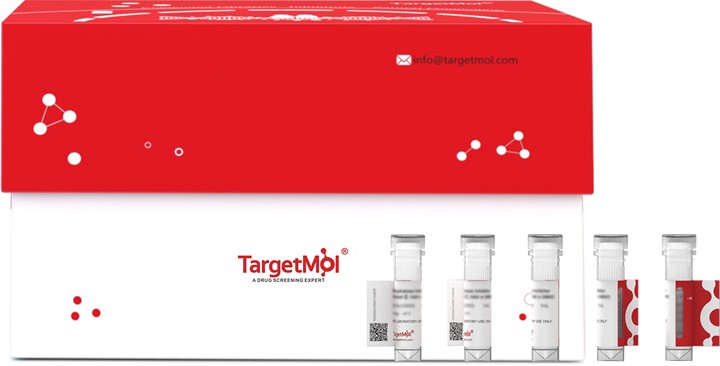 Your shopping cart is currently empty
Your shopping cart is currently empty
B7-H4 Protein, Human, Recombinant (hFc & Avi), Biotinylated
B7 Homolog 4 (B7-H4) is glycosylated member of the B7 family of immune costimulatory proteins. Mature human B7-H4 consists of a 235 amino acid (aa) extracellular domain (ECD) with two Ig-like V-type domains, a 21 aa transmembrane segment, and a 2 aa cytoplasmic tail. It is widely expressed, including in kidney, liver, lung, pancreas, placenta, prostate, spleen, testis and thymus. B7-H4 negatively regulates T-cell-mediated immune response by inhibiting T-cell activation, proliferation, cytokine production and development of cytotoxicity. When expressed on the cell surface of tumor macrophages, plays an important role, together with regulatory T-cells (Treg), in the suppression of tumor-associated antigen-specific T-cell immunity. It also involved in promoting epithelial cell transformation.

B7-H4 Protein, Human, Recombinant (hFc & Avi), Biotinylated
| Pack Size | Price | USA Warehouse | Global Warehouse | Quantity |
|---|---|---|---|---|
| 5 μg | $129 | 7-10 days | 7-10 days | |
| 10 μg | $213 | 7-10 days | 7-10 days | |
| 20 μg | $355 | 7-10 days | 7-10 days | |
| 50 μg | $625 | 7-10 days | 7-10 days | |
| 100 μg | $963 | 7-10 days | 7-10 days |
Product Information
| Biological Activity | Immobilized Anti-Human B7-H4 mAb at 2μg/ml (100 μl/well) can bind Biotinylated Human B7-H4-Fc-Avi. The ED50 of Biotinylated Human B7-H4-Fc-Avi is 0.23 ng/ml. (Regularly tested) |
| Description | B7 Homolog 4 (B7-H4) is glycosylated member of the B7 family of immune costimulatory proteins. Mature human B7-H4 consists of a 235 amino acid (aa) extracellular domain (ECD) with two Ig-like V-type domains, a 21 aa transmembrane segment, and a 2 aa cytoplasmic tail. It is widely expressed, including in kidney, liver, lung, pancreas, placenta, prostate, spleen, testis and thymus. B7-H4 negatively regulates T-cell-mediated immune response by inhibiting T-cell activation, proliferation, cytokine production and development of cytotoxicity. When expressed on the cell surface of tumor macrophages, plays an important role, together with regulatory T-cells (Treg), in the suppression of tumor-associated antigen-specific T-cell immunity. It also involved in promoting epithelial cell transformation. |
| Species | Human |
| Expression System | HEK293 Cells |
| Tag | C-hFc-Avi |
| Accession Number | Q7Z7D3 |
| Synonyms | Vtcn1,V-set domain containing T cell activation inhibitor 1,V-set domai,T cell costimulatory molecule B7x,Protein B7S1,Immune costimulatory protein B7-H4,FLJ22418,B7XPRO1291,B7x,B7S1VCTN1,B7S1,B7H4T-cell costimulatory molecule B7x,B7-H4,B7h.5 |
| Amino Acid | Phe29-Ala258 |
| Construction | Phe29-Ala258 |
| Protein Purity | Greater than 95% as determined by reducing SDS-PAGE. (QC verified) |
| Molecular Weight | 70-95 KDa (reducing condition) |
| Endotoxin | < 0.1 ng/µg (1 EU/µg) as determined by LAL test. |
| Formulation | Lyophilized from a solution filtered through a 0.22 μm filter, containing PBS, pH 7.4. |
| Reconstitution | Reconstitute the lyophilized protein in distilled water. The product concentration should not be less than 100 μg/ml. Before opening, centrifuge the tube to collect powder at the bottom. After adding the reconstitution buffer, avoid vortexing or pipetting for mixing. |
| Stability & Storage | Lyophilized powders can be stably stored for over 12 months, while liquid products can be stored for 6-12 months at -80°C. For reconstituted protein solutions, the solution can be stored at -20°C to -80°C for at least 3 months. Please avoid multiple freeze-thaw cycles and store products in aliquots. |
| Shipping | In general, Lyophilized powders are shipping with blue ice. Solutions are shipping with dry ice. |
| Research Background | B7 Homolog 4 (B7-H4) is glycosylated member of the B7 family of immune costimulatory proteins. Mature human B7-H4 consists of a 235 amino acid (aa) extracellular domain (ECD) with two Ig-like V-type domains, a 21 aa transmembrane segment, and a 2 aa cytoplasmic tail. It is widely expressed, including in kidney, liver, lung, pancreas, placenta, prostate, spleen, testis and thymus. B7-H4 negatively regulates T-cell-mediated immune response by inhibiting T-cell activation, proliferation, cytokine production and development of cytotoxicity. When expressed on the cell surface of tumor macrophages, plays an important role, together with regulatory T-cells (Treg), in the suppression of tumor-associated antigen-specific T-cell immunity. It also involved in promoting epithelial cell transformation. |
Dose Conversion
Calculator
Tech Support
| Size | Quantity | Unit Price | Amount | Operation |
|---|

Copyright © 2015-2025 TargetMol Chemicals Inc. All Rights Reserved.



